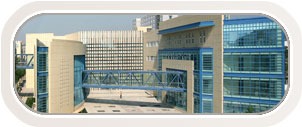 |
 |
| Old Library |
New Library |
Library history origin and development:
¡¡¡¡Tibet Nationalities College Library was established in 1958 accompanies with college¡¯s establishes. The independent premises was finished in 1987 for 4404 square meters¡¯ construction area£¬and the new building builds in 2005 with 10417 square meters£¬for a wail it put into use in September, 2006.There are 6 departments in library¡¯s organization currently: Editorial department, Circulation department, Reading department, Information Technology department, Business Counseling department and the Museum office. There are total 46 staff members in the library, including 31 formal staff members and 15 temporary staff. More than 50 in the last years, the library is in the light of the aim of "reader the first, service highest" and take "united enterprising and unselfish offer" as library training and drew up a more perfect management regulation system. It carries out the automation of business work completely and information-based manage, the staff member has to make people the center of service principle with good respect-work spirit, the service realm expands day by day and the function continuously strengthens becoming the important strength that helps the college to develop.
Library Collection Features:
¡¡¡¡There are 860,000 volumes of paper documents and more than 200,000 copys of e-books in the library. The electronics resources including ¡°Chinese Academic periodical¡± and other 7 databases£¬and there are many self-built databases as ¡°Full text of the Tibetan Documents Database¡± and ¡°Tibetan studies thematic database¡± etc. Library Collections particularly focus on the collections and conservancy of Tibetan literatures, including the collection of woodcut Tripitaka, The local records of China¡¯s Tibet and Yunnan, Gansu and Qinghai, The compilation of China Tibetan Affairs Historical Documents and other important Tibetan literature. It has been formed to a multidisciplinary integrated collection system with the combination of arts, science, economics, management, law, medicing, body after years¡¯ collection, and the Ethnology and Tibetan literature is the feature collection.
Library Reader Service:
¡¡¡¡The library continue to expand, extend and improve the service in space, time and functionality, it provides the service not only books borrow, reading, reference service£¬information retrieval, tracking SDI but also the individual service of document integration, document delivery, online consulting, video on demand, BBS with network information technology. The library is open hours up to 98 hours weekly, and the WEB server is open 24 hours a day, readers can browse, read and search our library information resources through the campus network and the Internet. After years of development, the library evolved into diverse types of literature, business management automation, services digital and the network information transmission center of literature, and it has played an irreplaceable role in safeguarding the documents and information supporting role in teaching and research in the hospital.
Library development:
¡¡¡¡In the new situation, the Library will implement a people-oriented philosophy and the scientific development outlook, based on construction of information resources, means to rely on information technology, to high-quality team of librarians as the key, to the diversity of information needs of the reader-oriented, and the library continue to explore new areas of library work and service work by learn from the advanced management mode and service mode at home and abroad. It meet the readers¡¯ growing demand for personalized information need by diversity and human service mode. We pay efforts to build the library as one of the modem National University Library by a set of information technology, digital, network and intelligence and the innovative ideas and forge ahead. We hope our library can play a stronger role in support of literature information for the college teaching, research, management, and make due contribution not only to the content-style development of the College and higher education in Tibet but also to the construction of national higher education resources sharing and digitization. |

